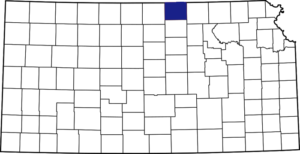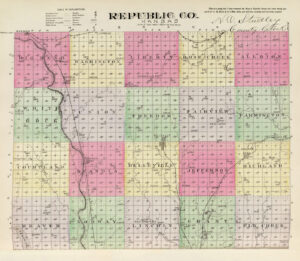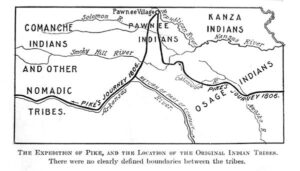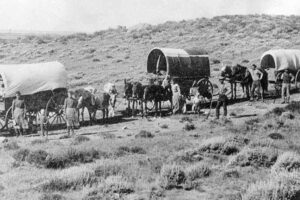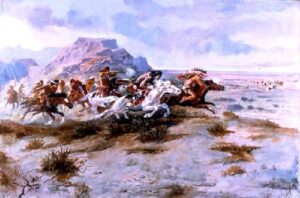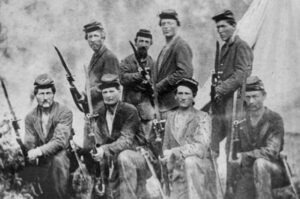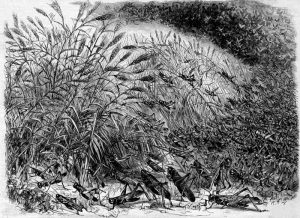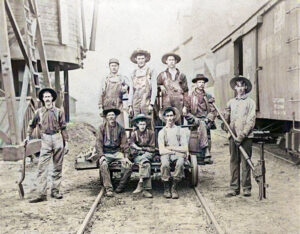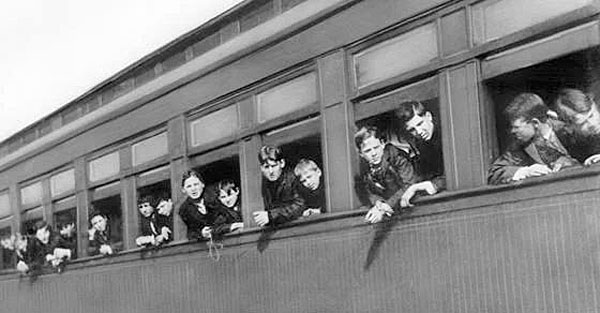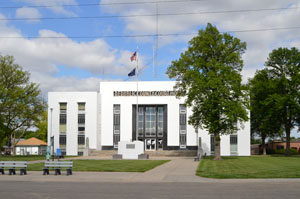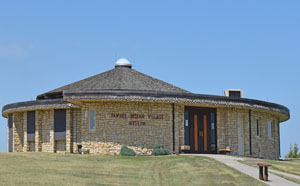Republic County, Kansas – Legends of Kansas (original) (raw)
Republican River in Republic County, Kansas, by Kathy Alexander.
Towns & Places:
Republic County, Kansas location.
Belleville – County Seat
Courtland
Cuba
Munden
Republic County, Kansas Map by L.H. Everts & Co., 1887.
Narka
Pawnee Indian Village Site
Republic-Gomeria
Scandia
Extinct Towns of Republic County
Belleville City Lake
Fort Lookout
Indian Troubles in Republic County
Republic County, Kansas, is located south of the Nebraska state line. Its county seat and largest city is Belleville. As of the 2020 census, the county population was 4,674.
The surface is a rolling prairie with 10% bottomland and 90% upland. The Republican River enters the county in the northwestern corner and traverses its entire width in a southerly direction; Mill and Rose Creeks flow east into the Little Blue River; White Rock Creek flows northeast, and Beaver Creek southeast into the Republican River; West and Elk Creeks flow south. The county is watered by numerous natural springs. The mineral products are coal, limestone, and salt, and the principal farm products are corn, wheat, and oats.
Before the arrival of settlers of European ancestry, the area was inhabited by Indian tribes, including the Pawnee, Ioway, and Otoe. Other nomadic Indian tribes pursued buffalo in the county, including the Arapaho, Cheyenne, Comanche, Kanza, Kiowa, Osage, and Wichita, and may have made the area their home at various times.
Zebulon Pike’s expedition in Kansas.
Republic County’s early history is interesting because it contained the site of the famous Pawnee Republic, and Captain Zebulon Pike raised the first American flag within its borders.
Sometime before the first settlement in the county, a company of 20 Mormons bound for Salt Lake City, Utah, was attacked near the present town of Scandia, and all but one were murdered. The dead were buried on a high bluff near the Republican River by soldiers, and triangular flagstones were put up to mark the spot.
In 1854, the Kansas Territory was organized under the Kansas-Nebraska Act provisions. In 1860, the Kansas legislature established Republic County. In 1861, Kansas became the 34th U.S. state. The county was named for the Republican River, which enters at the northwestern corner, flows slightly southeast, and leaves the county about eight miles east of the southwest corner.
Wagon Train
In 1857, the government opened a military road through this county, anticipating the building of which the wagon trains bound for California began to take this route before the bridges were built. One train with eight wagons, 25 people, and 400 heads of stock came to grief that year near Republic City. Their trail was dogged by the Indians from the settlements, and when 90 miles from the western outpost, they were attacked early in the morning, the train destroyed, and four men were killed. The remnant, including several wounded people and some women and children, made their way to the settlements, reaching help half dead and crazed from suffering.
The legislature of 1860 defined the boundaries of the county and gave it its name, taken from the Republican River, which was named from the Pawnee Republic. It is bounded on the north by Thayer and Nuckols counties, Nebraska; east by Washington County; south by Cloud County; and west by Jewell County. It is 125 miles on an air line, west of the Missouri River, and 90 miles northwest of the geographical center of the United States.
Daniel and Conrad Myers settled in Lincoln Township on February 28, 1861. It is said that Daniel Myers often left his claim during Indian alarms, but Conrad stayed on his claim, making the first settlement permanent. The first dwelling house was that of Daniel Myers, built in September 1861.
James F. Van Natta, David, and John Cory made the subsequent settlement in the spring of 1862. A Methodist Episcopal preacher, William Harshberger delivered the first religious service in Republic County. He came to the county with J.E. VanNatta and preached his first sermon to a small congregation at Mr. VanNatta’s house in April 1862. At the close of 1862, the population was 13. The county’s growth was slow during the Civil War, scarcely averaging three families a year.
The first organized resistance occurred in 1864, when the settlers of Clay, Cloud, and Republic Counties formed a company under Captain Isaac M. Schooly, whom the government commissioned.
No more permanent settlements were made until 1866 when James G. Tuthill settled near Seapo. The same year, J.C. Riley and his family settled near Belleville, D.N. Davis near Republic City, and Thomas Lovewell crossed the Republican and settled on White Rock Creek. Indians had driven out the settlers who had entered the county during the intervening years.
The first school opened in 1867 and had 13 pupils and Mrs. Margaret Tate as a teacher. It was a log house 18 by 20 feet built by Peter Moe.
Indian Attack by Charles Russell
That year, there was a significant influx of settlers, principally Scandanavians, a colony of 300 settling on White Rock Creek. As usual, the Arapahoe and Cheyenne came that year into the Republican River Valley. The settlers fortified their dugouts and kept guards on the bluffs until they supposed the Indians were gone. As soon as the guards were removed, the Indians came over the bluff, drove away seven horses, and killed a young son of F.E. Granstadt, who was watching them. That year, Captain Stanfield, A. Davis, W. P. Phillips, and Clarke Tenike were besieged in the blockhouse by over 100 Indians. A message was sent out tied to a cow’s tail. The cow reached Scandia the next day, but the Scandinavians were afraid to go to the rescue. In May, a party of seven hunters with J. McChesney as a guide was attacked on White Rock Creek, and all but McChesney were killed. This was the last of the fatalities from Indian attacks. In the next two years, immigration was heavy.
Republic County was organized in 1868 by the proclamation of Governor Harvey, who fixed the county seat at Pleasant Hill. The first election was held in March 1868. The county was one precinct, and only 13 votes were cast. J.C. Riley was chosen trustee; J.E. Van Natta, justice; and J.H. Frint, constable.
Early Kansas Militia.
The first militia, composed entirely of Republic County men, was the “Independent Company of Salt Creek Militia,” organized in 1868 with W. P. Peake as first lieutenant. He was subsequently made captain, and W.H.H. Riley was commissioned first lieutenant. There were 50 men in the company. The state furnished arms and ammunition, but the men furnished their own horses, saddles, and bridles. In the summer of 1868, another company of six men was recruited in the northern part of the county under Captain R.T. Stanfield, with Peter Johnson as first lieutenant. This company built a log fort in Belleville Township. The company made several expeditions into the Indian country. In August, Gordon Winbigler, who was harvesting with several other men, was killed by the Indians not far from the fort.
At the election in 1869, the permanent location of the county seat was voted on with the following result: Belleville 59 and New Scandinavia (Scandia) 42, with a couple of votes going to other locations. Daniel Myers was elected judge of the Probate court, and Conrad Myers to a seat on the County Commission. The first courthouse was constructed that year for $3,000. The poor farm of 160 acres, situated two miles west of the county seat, had a very neat and comfortable dwelling house and good smaller buildings necessary to a farm.
The first post office was in Salt Marsh (Seapo) in Grant Township, with James G. Tuthill as postmaster. The first lawsuit was tried before Justice Van Natta in 1869, when Henry Mead sued Conrad Myers for breach of contract, each acting as his own lawyer, as there was no attorney nearer than Manhattan. At that time, the county’s law library consisted of the “Territorial Laws” of 1859, the session laws of 1865, the Testament and Psalms, and the Blue Laws of Connecticut.
The first newspaper in the county was the Belleville Telescope, established in September 1870 by James C. Humphrey.
The first agricultural society in Republic County was organized on February 20, 1871, with the following officers: Albert Odell, president; R.P. West, vice president; I.O. Savage, secretary; John M. Ryan, treasurer.
A. B. Wilder established the Scandia Journal on February 7, 1872, in Belleville under the name of the Belleville Republic.
In 1873, bonds were voted for to extend the Central Branch Railroad into the county. They were never issued as the railroad company failed to keep its part of the agreement.
The most fatal storm known in the history of Republic County was the great Easter storm of April 13, 14, and 15, 1873. The wind blew like a hurricane from the north with rain and snow, and the thermometer for the first day stood at freezing point. One family six miles east of Belleville, fearing their frame house would be carried away, went to a neighbor’s, who lived in a stone house, for safety. The husband of one of the families was in Waterville, and the other had gone to another neighbor for assistance, but the latter, believing there was no danger, would not take his team from the barn. When the husband returned, he found his house blown down and the two families, seven in all, scattered about the prairie, frozen to death. The pouring rain had saturated their clothing, which was soon frozen, encasing their bodies in ice. One woman was found with a babe in her arms, sitting against a wagon wheel around whose spokes her hair had been caught and fastened with sleet. She was dead, and the child, which was still alive, soon expired. The frame house that was deserted was not materially injured by the storm. The wind blew so strong that no beast could face it without soon becoming exhausted.
Grasshoppers, 1874.
The Grasshopper Invasion of 1874 hit the county and caused damage.
Another railroad attempt was made in 1878 to get a road with the Kansas Pacific Railroad. The proposal to issue bonds for $4,000 per mile was lost at the election. On December 24 that year, the Missouri Pacific Railroad ran its first train to Scandia over a line extended from Concordia.
The county horticultural society was organized in 1879.
In 1880, a Burlington and Missouri River Railroad branch was extended through the county’s eastern portion.
In the early 1880s, the county had 108 organized school districts with a total population of 4,274. The average salary of teachers per month for males was 28.11;forfemales,itwas28.11; for females, it was 28.11;forfemales,itwas22.11. There were 101 total schoolhouses, and the value of all school property was $53,497.
The Republic City News was started in 1881 by William Ketchum.
In 1884, the Union Pacific Railroad was extended from Junction City to Belleville, and a branch of the Burlington & Missouri River was extended through the county 18 miles.
Union Pacific Railroad Crew in Belleville, Kansas.
George Ropes designed the second courthouse. The three-story building was erected in 1885 of brick by Hulse & Mosses and Ulrich Brothers for $24,344. It was destroyed by a fire in 1938
In 1887, the Rock Island Railroad built 54 miles of track. The same year, the Atchison, Topeka & Santa Fe Railroad built a branch line from Neva, three miles west of Strong City, to Superior, Nebraska. This branch line connected Strong City, Neva, Rockland, Diamond Springs, Burdick, Lost Springs, Jacobs, Hope, Navarre, Enterprise, Abilene, Talmage, Manchester, Longford, Oak Hill, Miltonvale, Aurora, Huscher, Concordia, Kackley, Courtland, Webber, and Superior. The line from Neva to Lost Springs was pulled at some point, but the right of way had not been abandoned. This branch line was initially called the “Strong City and Superior Line,” but later, the name was shortened to the “Strong City Line.”
The Courtland Register was established in 1889 by F.M. Coffey.
Republic County’s population peaked in 1890 at 19,002
The Narka News was first published in 1893 by James A. Harris. The other papers in the county were the Republic County Democrat at Belleville, God’s Missionary Record (quarterly) at Belleville, the Cuban Daylight, Cuba, and the Comet at Courtland.
In 1909, an orphan train stopped in the county, and many came out to find a child to adopt. Orphan trains were a way for homeless children fending for themselves in the New York City area to find homes in the West.
Kansas Orphan Train.
Republic County Courthouse in Belleville, Kansas, by Kathy Alexander.
In 1910, the county had five railroads with an aggregate of 140 miles. These included the Chicago, Burlington & Quincy, the Missouri Pacific, the Chicago, Rock Island & Pacific, the Atchison, Topeka & Santa Fe, and the Union Pacific.
The Republic County Courthouse was built from 1938 to 1939 by Peterson Construction Company of Salina, Kansas. Architects Mann & Company of Hutchinson, Kansas, designed the courthouse in the Art Deco style. The four-story courthouse was constructed of white-colored concrete, glass, and concrete with a flat roof on spacious landscaped grounds. The construction cost was 250,532,ofwhichaPublicWorksAdministrationgrantcovered250,532, of which a Public Works Administration grant covered 250,532,ofwhichaPublicWorksAdministrationgrantcovered112,936 of the total cost. It is located at 1815 M Street in Belleville.
In the 20th Century, Republic County’s population dropped each decade.
Farming continues to be important to the county, among the state’s leading soybean producers.
©Kathy Alexander/Legends of Kansas, updated October 2024.
Also See:
Pawnee Indian Museum in Republic County, Kansas, by Kathy Alexander.
Sources:
Blackmar, Frank W.; Kansas: A Cyclopedia of State History, Vol I; Standard Publishing Company, Chicago, IL 1912.
Cutler, William G; History of Kansas; A. T. Andreas, Chicago, IL, 1883.
Kansas Post Office History
Wikipedia
Savage, I.O.; A History of Republic County, Kansas, Jones & Chubbic, Beloit, KS, 1901.

